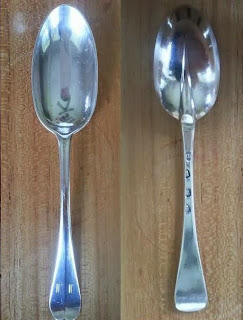Today I'd like to talk about engravings on flatware, and post some photos from my little collection. While I don't collect flatware based on the crest, the crests and engravings definitely add to the piece's interest. It's always fun to try and find the families associated with the crests, although it's quite difficult to attribute a crest to one specific family since the same crest was used by several.
The crests with mottoes are easier to attribute. I have attributed the tablespoon below with the motto "Lock Sicker" to the Douglas family, who were the Earls of Morton, and, based on the 1717 date of the spoon, tentatively suggest that it belonged to George Douglas, 13th Earl of Morton, who was born in 1662 and died in 1738. He didn't succeed to the earldom until 1730, and at that time didn't add an earl's coronet to this spoon. I have seen several pieces of silver that appear to have a later earl's coronet engraved over an earlier coat of arms or crest, presumably done so that the owner's dinner guests would be apprised of his updated status. One of George Douglas's brothers, James, died in 1715, too early to have had this spoon made, and the next brother, Robert, succeeded to the earldom in 1715. I would assume that had Robert had this spoon made in 1717, he would have had an earl's coronet included in the engraving. Thank you to
The Douglas Archive for supplying information on the Earls of Morton.
I have attributed the crest and motto "Festina Lente" on the Britannia-standard spoon below of 1724 to Sir Martin Westcombe, 1st Baronet, consul and agent at Cadiz, Spain. "Festina Lente" translates as "hasten slowly." I'm digging its oxymoronicity.
The stag's crest on the table fork below is actually the crest used by the
Austen family, as in Jane Austen. Of course, several other families used this crest, and based on the fact that the coat of arms on the front of the fork seems to have nothing whatsoever to do with the Austen family, and I can't date the fork, *sigh* I have given up hope that Jane herself might have eaten from this very fork.
The only other piece of flatware that I can attribute to a specific family is the 1712 spoon with the coat of arms and the letters "MT" below it. This one I have attributed to the Weld family, so the "MT" might be a later addition.
The engravings on the reverse of the spoons and forks I have can be organized into the following types: crests, crests with motto, coats of arms, cypher, and initials. Below are a few photos of these types. (Apologies for the less-than-stellar photography skills.)
 |
| From left to right: bull crest, table fork, Dublin, 1789, Michael Keating; stag crest, table fork, marks worn; arm in armour crest, dessert fork, London, 1736, John Smith | | | | | |
|
|
 |
| From left to right: stork crest, tablespoon, London, 1712, John Ladyman; griffin crest, dessert spoon, 1702, John Ladyman; owl crest, tablespoon, London, 1716, George Lambe; man crest, tablespoon, London, 1718, George Lambe |
 |
| From left to right: Lock Sicker motto, tablespoon, London, 1717, Andrew Archer; Festina Lente crest, tablespoon, London, 1724, Jane Lambe; cypher, tablespoon, London, 1709, Joseph Barbut; crest, tablespoon, London, 1712, maker's mark worn |
 |
| From left to right: NHS, tablespoon, London, no date letter, Thomas Sadler; LH, table fork, London, 1711, Andrew Archer; AW, tablespoon, London, 1714, Isaac Davenport |
 |
| From left to right: DF, teaspoon, London, no date letter, John Ladyman; crest, front of table fork, marks unclear; EI, teaspoon, London, no date letter, Samuel Hitchcock |
I think my favorite crest is the one of the griffin, in the second photo, engraved on the back of a set of darling dognose dessert spoons. I would love to see the crests and engravings on your flatware. I am also curious to know if any of you have flatware with the same engravings as I have posted.
Sources:
"The Austen Coat of Arms and Seal." Austenonly. WordPress, 9 Mar. 2012.
Web. 20 Nov. 2013.
"The Earls of Morton." The Douglas Archives: a Collection of Historical and
Genealogical Records. The Douglas Archives, n.d. Web. 20 Nov. 2013.














